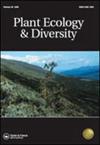Arable wildflowers have potential as living mulches for sustainable agriculture
IF 1.6
4区 生物学
Q2 PLANT SCIENCES
引用次数: 1
Abstract
ABSTRACT Background As agriculture has intensified, many once-common wildflowers have declined in arable landscapes, which has widespread implications for associated ecosystem services. The incorporation of sustainable practices, for example, growing living mulches (in-field, non-crop plant ground cover, maintained during the target crop growing season), can boost arable biodiversity, but few wildflower species have been utilised in this context. Aims Our aim was to determine the suitability of arable wildflower species, once considered weeds, for use as living mulches. Methods We first screened a number of arable wildflower species for germination when growing with a common cereal, barley (Hordeum vulgare). We then grew two (Centaurea cyanus and Scandix pecten-veneris) in pots in a glasshouse with and without barley, and grew barley alone to test the impact of the wildflowers on barley growth and biomass. Results Neither of the wildflowers significantly negatively impacted barley biomass. Barley initially facilitated germination in S. pecten-veneris, but ultimately suppressed the above-ground biomass of both wildflowers. However, both wildflower species were able to coexist alongside barley. Conclusions Our experiment provides evidence that wildflowers that were considered weeds in traditional agriculture have the potential to be grown alongside barley and could be incorporated as part of a living mulch.可耕种的野花有潜力成为可持续农业的活覆盖物
随着农业的发展,许多曾经常见的野花在耕地景观中已经减少,这对相关的生态系统服务具有广泛的影响。结合可持续的做法,例如种植活地膜(在目标作物生长季节保持的田间非作物植物地面覆盖),可以促进耕地生物多样性,但很少有野花物种在这方面得到利用。我们的目的是确定可耕地野花物种的适宜性,曾经被认为是杂草,用作生活覆盖物。方法我们首先筛选了一些与大麦(Hordeum vulgare)共同生长的可耕种野花品种。然后,我们在有大麦和没有大麦的温室中种植了两种(Centaurea cyanus和Scandix pecten-veneris),并单独种植大麦,以测试野花对大麦生长和生物量的影响。结果两种野花对大麦生物量的影响均不显著。大麦最初促进了葡萄球菌的萌发,但最终抑制了这两种野花的地上生物量。然而,这两种野花都能与大麦共存。我们的实验提供了证据,证明在传统农业中被认为是杂草的野花有潜力与大麦一起种植,并且可以作为活覆盖物的一部分。
本文章由计算机程序翻译,如有差异,请以英文原文为准。
求助全文
约1分钟内获得全文
求助全文
来源期刊

Plant Ecology & Diversity
PLANT SCIENCES-
CiteScore
3.30
自引率
0.00%
发文量
26
审稿时长
3 months
期刊介绍:
Plant Ecology and Diversity is an international journal for communicating results and novel ideas in plant science, in print and on-line, six times a year. All areas of plant biology relating to ecology, evolution and diversity are of interest, including those which explicitly deal with today''s highly topical themes, such as biodiversity, conservation and global change. We consider submissions that address fundamental questions which are pertinent to contemporary plant science. Articles concerning extreme environments world-wide are particularly welcome.
Plant Ecology and Diversity considers for publication original research articles, short communications, reviews, and scientific correspondence that explore thought-provoking ideas.
To aid redressing ‘publication bias’ the journal is unique in reporting, in the form of short communications, ‘negative results’ and ‘repeat experiments’ that test ecological theories experimentally, in theoretically flawless and methodologically sound papers. Research reviews and method papers, are also encouraged.
Plant Ecology & Diversity publishes high-quality and topical research that demonstrates solid scholarship. As such, the journal does not publish purely descriptive papers. Submissions are required to focus on research topics that are broad in their scope and thus provide new insights and contribute to theory. The original research should address clear hypotheses that test theory or questions and offer new insights on topics of interest to an international readership.
 求助内容:
求助内容: 应助结果提醒方式:
应助结果提醒方式:


